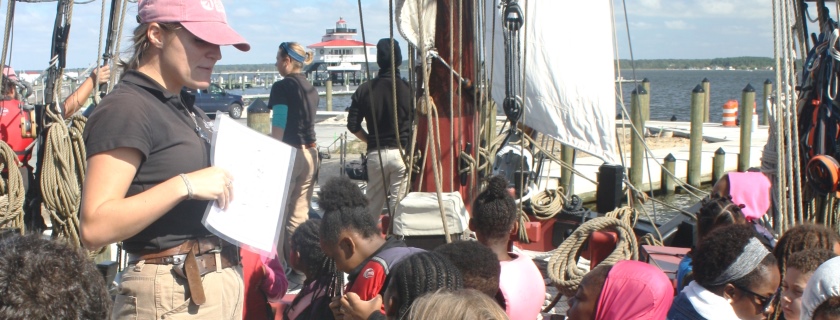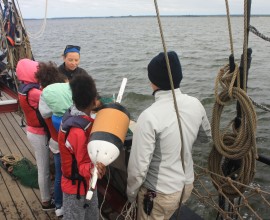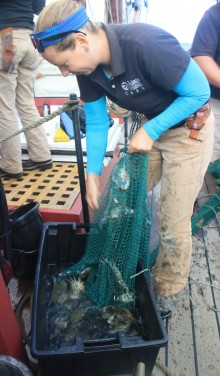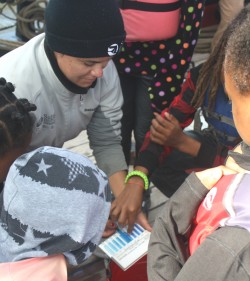
Students Experience Choptank Habitat Focus Area
“CHOP!”
“TANK!”
“CHOP!”
“TANK!”
The voices—“Chop” from Sultana Education Foundation educators, “tank” from Sandy Hill Elementary School fifth-graders—echoed across the waters off Cambridge, Maryland, as they hoisted sails on the Sultana on a cool October morning.
Having teamed up to provide the sail power, enabling the Sultana to tack across the Choptank River at a stately 3.5 knots, the students then broke into groups to learn more about the river—and its residents. Educators guided students as they measured salinity and dissolved oxygen in the river, and learned what different levels mean for fish and crabs that live there.
And speaking of fish and crabs, the group deployed and retrieved an otter trawl, or net, that came back full of crabs and fish. Those samples let the education staff describe how different species exhibit features that help them survive—like the darker-on-top, lighter-on-the-bottom coloring of pufferfish and the spiny dorsal fin of white perch. Students got up close and personal with the fish and crabs, helping create a connection with their local river. Some students are literally crab kissers!


As the Sultana returned to the dock, the ship’s captain reviewed with the students what they experienced and learned that morning, and asked if there were any questions. One girl thrust her hand up, and when the captain invited her to ask her question, she clarified: “I don’t have a question. I have a statement: That was FUN!”
NOAA couldn’t agree more that getting students outside to have meaningful educational experiences is a critical way to augment classroom learning, and that professional development for teachers—giving them the tools and information about the latest science to help them most effectively deliver that classroom learning—is a key part of the process.
That’s why, through its competitive B-WET (Bay Watershed Education and Training) grant program, NOAA supports programs that provide hands-on environmental education about issues affecting the Chesapeake Bay watershed for students and related professional development for educators who serve formal K-12 audiences.
The NOAA Chesapeake Bay Office included in its FY15 Request for Proposals for B-WET grants a “special interest area,” to encourage projects that will address systemic Meaningful Watershed Educational Experience (MWEE) implementation or MWEE capacity building in the Choptank HFA. Funding ($111,318 in fiscal year 2015 funds) awarded through that process to Sultana Education Foundation is enabling it to deliver its “Choptank Choices” program—like the field experience for those crab-kissing fifth-graders—to students in the Choptank watershed’s Talbot, Caroline, and Dorchester counties in partnership with those counties’ school systems.

In addition to funding, the NOAA Chesapeake Bay Office provides expertise and content to Sultana Education Foundation staff and public school teachers, through teacher and educator trainings.
Together, those trainings, field experiences, and classroom learning add up to an effective way to connect future stewards of the Choptank watershed with their ecosystem, helping them learn how land use affects water quality, which in turn affects the fish and crabs that live there. And we agree—learning can be fun, too!
